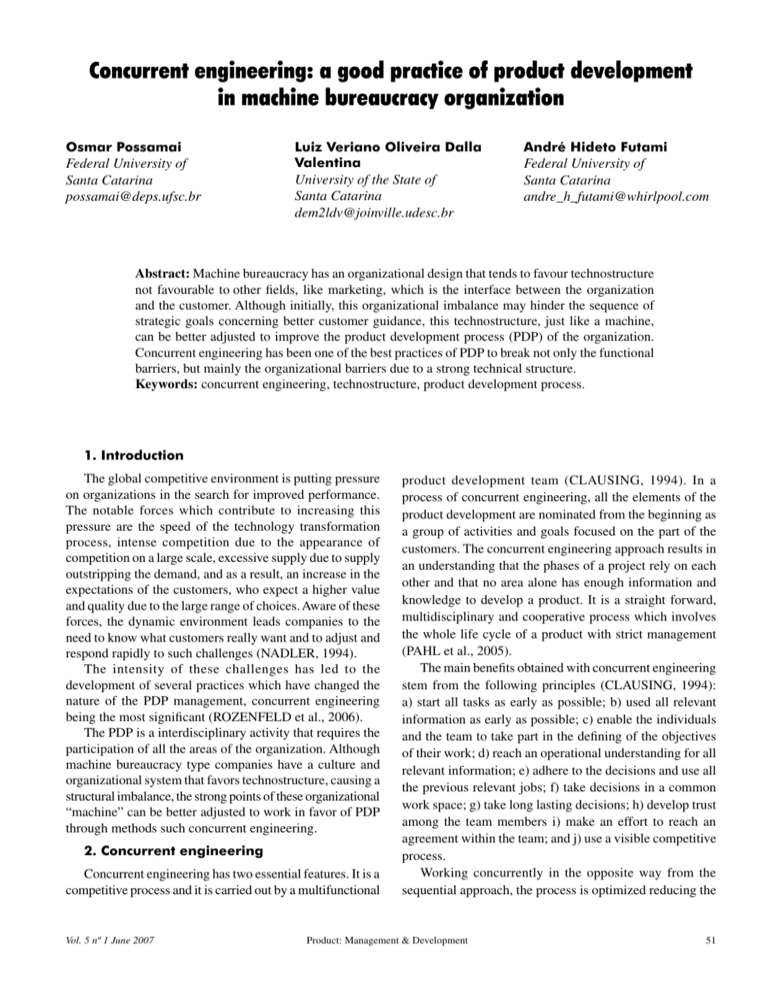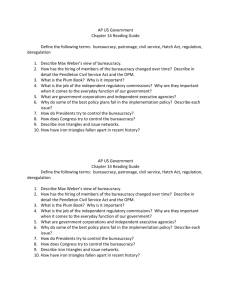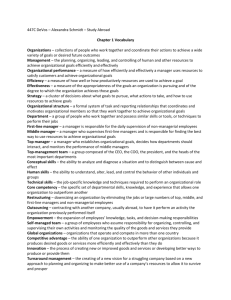Concurrent engineering: a good practice of product development in
advertisement

Concurrent engineering: a good practice of product development in machine bureaucracy organization Osmar Possamai Federal University of Santa Catarina possamai@deps.ufsc.br Luiz Veriano Oliveira Dalla Valentina University of the State of Santa Catarina dem2ldv@joinville.udesc.br André Hideto Futami Federal University of Santa Catarina andre_h_futami@whirlpool.com Abstract: Machine bureaucracy has an organizational design that tends to favour technostructure not favourable to other fields, like marketing, which is the interface between the organization and the customer. Although initially, this organizational imbalance may hinder the sequence of strategic goals concerning better customer guidance, this technostructure, just like a machine, can be better adjusted to improve the product development process (PDP) of the organization. Concurrent engineering has been one of the best practices of PDP to break not only the functional barriers, but mainly the organizational barriers due to a strong technical structure. Keywords: concurrent engineering, technostructure, product development process. 1. Introduction The global competitive environment is putting pressure on organizations in the search for improved performance. The notable forces which contribute to increasing this pressure are the speed of the technology transformation process, intense competition due to the appearance of competition on a large scale, excessive supply due to supply outstripping the demand, and as a result, an increase in the expectations of the customers, who expect a higher value and quality due to the large range of choices. Aware of these forces, the dynamic environment leads companies to the need to know what customers really want and to adjust and respond rapidly to such challenges (NADLER, 1994). The intensity of these challenges has led to the development of several practices which have changed the nature of the PDP management, concurrent engineering being the most significant (ROZENFELD et al., 2006). The PDP is a interdisciplinary activity that requires the participation of all the areas of the organization. Although machine bureaucracy type companies have a culture and organizational system that favors technostructure, causing a structural imbalance, the strong points of these organizational “machine” can be better adjusted to work in favor of PDP through methods such concurrent engineering. 2. Concurrent engineering Concurrent engineering has two essential features. It is a competitive process and it is carried out by a multifunctional Vol. 5 nº 1 June 2007 product development team (CLAUSING, 1994). In a process of concurrent engineering, all the elements of the product development are nominated from the beginning as a group of activities and goals focused on the part of the customers. The concurrent engineering approach results in an understanding that the phases of a project rely on each other and that no area alone has enough information and knowledge to develop a product. It is a straight forward, multidisciplinary and cooperative process which involves the whole life cycle of a product with strict management (PAHL et al., 2005). The main benefits obtained with concurrent engineering stem from the following principles (CLAUSING, 1994): a) start all tasks as early as possible; b) used all relevant information as early as possible; c) enable the individuals and the team to take part in the defining of the objectives of their work; d) reach an operational understanding for all relevant information; e) adhere to the decisions and use all the previous relevant jobs; f) take decisions in a common work space; g) take long lasting decisions; h) develop trust among the team members i) make an effort to reach an agreement within the team; and j) use a visible competitive process. Working concurrently in the opposite way from the sequential approach, the process is optimized reducing the Product: Management & Development 51 total product development cycle. In this way, the project is able to mature earlier and with a higher quality. Strategic apex 52 Tec h aff An organization is organized so as to capture and run the workflow systems and define the interrelationships of the different parts that constitute the five basic parts (MINTZBERG, 2003). The visual model is shown below (Figure 1). MINTZBERG, (2003) proposes five structural configurations to describe an organization: simple structure, machine bureaucracy, professional bureaucracy, divisionalized form and adhocracy. For each configuration a coordination mechanism is dominant, and a different part oversees the organization, having a more important role, with a different kind of Middle line t st por 3.1. Machine bureaucracy according Mintzberg S up The term “bureaucracy” was used by Max Weber, a German sociologist, in the beginning of the 20th century to technically describe a specific type of organizational structure. Weber´s model prescribes the mechanization of work and involves many concepts, like the work division, specialization, formalization of behavior, authority hierarchy, command chain, regulated communication, processes and work skills standardization (MINTZBERG, 2003). In the USA, Frederick W. Taylor developed a scientific model of organization that focused on the operational work (MINTZBERG, 2003). Taylor´s scientific management (TAYLOR, 1995) was based on the division and prescription of work, when the image of the manual worker was first created, aiming at making the worker more productive. Machine bureaucracy, which came from the merging of Taylor and Weber`s ideas, the model of which conceives the organization as a machine, managed to set performance and productivity standards which have lasted up to the present day. This model has contributed to the huge increase in industrial productivity (NADLER & GERSTEIN, 1994). Taylor´s and Weber´s principles represent a great advance in terms of organization, if compared to the feudal and tribal systems (NADLER & GERSTEIN, 1994). These structures were the first expressions of the high level of specialization of today’s society and were those which contributed most to the high standard of living that we see today (MINTZBERG, 2003). Weber´s bureaucracy is known for its formal rationality, with organizations regulated by rules and structures. The rational process has four relevant principles: efficiency, calculation, predictability and control through technology. Thus, the bureaucratic model is suitable in stable and predictable environments. Weber´s model made the mass production strategy possible, with a stable demand and the market behaving in a homogeneous way. nos truc ture 3. The bureaucracy according Max Weber Operating core Figure 1. The five basic parts of the organization. importance. MINTZBERG, (2003) approach illustrates the pure structures present, making easier an understanding of which forces tend to drive an organization. The organizations are pushed in five different directions and according to the forces, an organization is structured according to one of the five structural configurations mentioned above. When conditions are favorable toward standardization, the organization is driven towards to machine bureaucracy. The technostructure exerts a force toward standardization, mainly of the work processes, since the design of standards is its reason for existing. The main features of machine bureaucracy are a highly specialized routine with highly standardized work processes that are made to operate as a regulated machine. It is the structure closest to that described by Max Weber (MINTZBERG, 2003). 4. Marketing and technical role in PDP With the industrial revolution and the principles of Taylor´s scientific management, the production determined the market direction. During this period, it was the manufacturing area which defined the strategies, which emphasized the efficiency of the internal operations and the cost control. The customer needs played a minor role. Nowadays, the marketing area performs a strategic role. The concept of modern marketing takes a perspective from the outside to the inside, starting and ending with the customer, being the area which interfaces with the customer. Developing a strategy focused on the customer involves a strategy and a marketing plan, together with a mission and goals for the organization. The marketing plan must be developed along with plans from other areas. However, the marketing plan will not be effective if the whole organization is not focused on meeting the customer needs (FERREL et al, 2000). Concurrent engineering: a good practice of product development in machine bureaucracy organization Possamai et al. Vol. 5 nº 1 June 2007 Manager laboratory General manager technology Manager platform 3 Despite the fact that the organizational chart doesn’t show the informal relationships and the communication, the power and non hierarchical relationships, it functions as an organizational map and provides an accurate framework of work division, the posts, how they are linked and how the formal authority flows (MINTZBERG, 2003). The organization follows a traditional functional structure with a board of directors subdivided and grouped by function. The marketing area answers to a specific board which is different from that of the technical area, which is subordinate. The technical area represented by the technology and manufacturing board, is divided into two structures, the general management of technology and the general management of manufacturing. The technology area is responsible for the product design and development, and the manufacturing area for the transformation of raw-materials into the finished goods. The structure of the manufacturing area follows the classic design, divided into functions such as: manufacturing, assembly, quality and industrial engineering. The division of work follows the traditional model. The technology area Manager platform 2 5.1. Organizational structure Manager platform 1 The organization under study is the Brazilian branch of one of the large worldwide household appliances manufacturers, located in the south. It is widely known that its main goal is to be an organization focused on the customer. Its mission is to provide solutions that can improve people’s standard of living through the excellence of its products and services. Meeting customer needs and exceeding customer expectations has become one of the greatest challenges for the organization. From this statement, the customer and market concern is just the beginning of a product’s development, aiming to achieve not only quality products, but more importantly, complete customer satisfaction. Subsystems 5. Case study structure has a matrix design which is implemented with the purpose of maximizing the use of the competences of experts. One of the advantages of the organizational structure is that it allows more flexibility in the use of resources than a structure according to projects (MENDES & TOLEDO, 2003). With the matrix design, the organization shows that there wasn’t the choice of one grouping rather than another, instead, both were chosen. By choosing them, the double structure of authority is determined. In this way, the structure sacrifices the hierarchical command (MINTZBERG, 2003). The organizational structure in the field of technology is based on two other structures: the functional (vertical) and by projects (horizontal). It is the design that joins people and resources at the same time by function or projects. The vertical control is carried out by the manager while the horizontal control is carried out by a project leader (Figure 2). The vertical structure is represented by the product platforms with a hierarchical control ruled by the manager. The platforms have the capacity and autonomy to execute and perform the improvement projects, along with a multidisciplinary team where all the subsystems are represented. The platforms are responsible for the project maintenance throughout the product life cycle. The horizontal structure of the technology area, along with the project teams, are incorporated and called subsystems. The subsystem is a grouping carried out by area of knowledge and is responsible for seeking the information related to its discipline. The subsystem is in charge of the fundamental work before the technology is made available to the product platform and the project teams. The project team, unlike the platforms and subsystems, are groups Project teams The focus on the customer has strategic results in PDP. The importance of the alignment between the PDP and the organizational strategic planning is notable, where the search for customer satisfaction involves the introduction of their needs, wants and preferences in all stages of the organization development process. The initial PDP stages are the most critical in determining the success of a product, they are where the main decisions are taken (ROZENFELD et al.,2006), in which the customer needs are identified and turned into a project requirement. This initial stage, which is focused on the initial product planning prior to the carrying out of the engineering project, must occur with the marketing area (ROZENFELD et al.,2006). Leader subsystem 1 Leader subsystem 2 Leader subsystem 3 Leader project 1 Leader project 2 Platforms/laboratory Figure 2. Technology’s structure. Product: Management & Development 53 formed inside the concept of concurrent engineering, formed temporarily, which are active while the respective project lasts. The technical area of engineering and manufacturing is a large structure made to ensure the continuous flow of operation with high productivity. 5.2. Machine bureaucracy characterization The structural configuration of the organization tends toward machine bureaucracy, because the forces are driven toward the standardization of the work process. It is an organization dealing with the mass production of consumer goods, sequential manufacturing and low customization, typical of machine bureaucracy. The equipment for the manufacture of standardized components is complex and highly specialized, and a change to new products incurs calculated cost losses with some flexibility. For all of the procedures involved in the technical area, like the product development process and the manufacturing process, the operational actions always tend to decrease in cost and quality. An analysis of the structure of the most used indicators by the technical area of engineering and manufacturing shows that they are defined as a function of cost and quality. 5.3. Organizational equilibrium through the concurrent engineering The marketing and the technical areas have always had a complex and stormy relationship in the PDP. The conflict stems from a confrontation of business functions, from the nature of their goals and the cultural aspects of their human resources. The marketing objective is essentially evaluated under a strategic perspective, like sales growth and market share. However, the direction of the engineering and manufacturing area is toward the maintenance of the continuous flow of operations, focusing primarily on the minimization of cost and increase in productivity levels. Therefore, each area separately attempts to reduce their operational costs and maximizing the benefits (Figure 3). One of the causes of this distortion is the functional imbalance that originates from the machine bureaucracy structure that benefits the technostructure in such a way that the system of power can be kept in the most technical areas. The machine bureaucracy structure in the organization is demonstrated by the force with which it is executed by the engineering and manufacturing area over the other areas. The technical areas tend to dominate other areas and dictate the organizational priorities. Therefore, an organization with a view more focused on the customer must have mechanisms that provide a better balance of power. In the past, the marketing area took a passive approach during PDP. As a leader in the national market, the performance of the marketing area was withdrawn and of 54 little effective in the determination of the requirements of a new product, allowing the engineering and manufacturing area the initiative and responsibility to take this idea ahead. Nowadays, with PDP carried out through concurrent engineering groups, and with an active marketing area, we are managing to realign this imbalance observed during the determination of product requirements. With the growth accomplished through the use of concurrent engineering and the developed achieved over the past fifteen years, its practice is now considered as a cultural factor of the organization in the carrying out of its projects. 6. Conclusions In organizations that fit into a typical machine bureaucracy, the power tends to concentrate in technical areas, such as manufacturing and engineering, which still dictate the rules in the process of defining the organizational strategies. This power has a harmful effect nowadays, when product development focused on the customer is a matter of survival. The elements that characterize machine bureaucracy can be better used in order to improve the PDP of an organization. It is a model of work build around a clear system of hierarchy with a well defined command chain, regulated by clear and coherent rules and written procedures where technical competence is essential for position placements. The elements mentioned which describe a “machine” should be taken into account in order to adjust the organizational system as a function of the PDP. Finally, according to the case study presented, concurrent engineering seems to be an excellent practice for PDP, to break the cultural, functional and organizational barriers of these kind of organizations. 7. References CLAUSING, D. Total quality development: a step-by-step guide to world-class concurrent engineering. New York: ASME Press, 1994. 130p. FERREL, O. C. et al. Estratégia de marketing. São Paulo: Atlas, 2000. 312p. MENDES, G. H. S; TOLEDO, J. C. Uma visão dos principais arranjos organizacionais aplicados ao desenvolvimento de produto. In: CONGRESSO BRASILEIRO DE GESTÃO E DESENVOLVIMENTO DE PRODUTOS, 4., Anais... Gramado, 2003. MINTZBERG, H. Criando organizações eficazes: estruturas em cinco organizações. São Paulo: Atlas, 2003. 334p. NADLER, D. A; GERSTEIN, M. S. Projetos de sistemas de trabalho de alto desempenho: como organizar pessoal, Concurrent engineering: a good practice of product development in machine bureaucracy organization Possamai et al. Vol. 5 nº 1 June 2007 Product: Management & Development 55 Director 3 Productivity Leader project 2 Leader project 3 Leader system 2 Leader system 3 Figure 3. Power imbalance due to the force of the technostructure. Leader project 1 Man. laboratory Man. platform 3 Director 4 Procurement Leader system 1 Man. platform 2 Gen. manager Technology A Plat; Sist; Lab. F- Plat; Syst.; Lab. E- Plat; Syst.; Lab. D- Plat; Syst.; Lab. C- Plat; Syst.; Lab. B- Plat; Syst.; Lab. A- Plat; Syst.; Lab. Gen. manager Technology Director 2 Technology Man. platform 1 Plant 4 Plant 3 Plant 2 Plant 1 Gen. manager manufacturing Director 1 Manufacturing Director I Eng; Man; Proc; Qual Director I Eng;Man;Proc;Qual Director II International Sales Marketing’s force Plant 4 Plant 3 Plant 2 Plant 1 Gen. manager manufacturing Manager Information tech Technostructure’s force Legend: Metal & plastic Assembly Indust. eng. Quality Design Mkt Logistic Customer A. Mkt Sales Mkt Service Strategic planning Finance Mkt Brands Mkt Prod.Dev. Gen. manager Gen. manager Director II Director III Director IV International sales Mkt; sales; log; serv Fin; stra. plan; it Director IV Fin;Strat.Plan;IT Director 1 Manufacturing Director III Mkt;Sales;Log;CA President Latin America Comunication & legal relations trabalho, tecnologia e informação. In: NADLER, D.A; GERSTEIN, M.S; SHAW, R.B. Arquitetura organizacional: a chave para a mudança empresarial. Rio de Janeiro: Campus, 1994. p 75-98. NADLER, D. A. Arquitetura organizacional: metáfora para mudança. In: NADLER, D.A; GERSTEIN, M.S; SHAW, R.B. Arquitetura organizacional: a chave para a mudança empresarial. Rio de Janeiro: Campus, 1994. p 112-145. 56 PAHL, G. et al. Projeto na engenharia. São Paulo: Edgard Blücher, 2005. 412p. ROZENFELD, H, et al. Gestão de desenvolvimento de produto: uma referência para a melhoria do processo. São Paulo: Saraiva, 2006. 576p. TAYLOR, F. W. Princípios de administração científica. São Paulo: Atlas, 1995. 112p. Concurrent engineering: a good practice of product development in machine bureaucracy organization Possamai et al.






